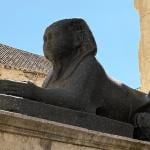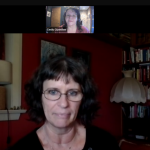Just to be through, I’m concluding this prefatory series with three groups that have been very important in Craft and Pagan history and that, at last technically, did predate the arrival of Gardnerian Craft in America.
The Church of All Worlds
I have puzzled over where to fit the Church of All Worlds into the stories I am telling, because they were not at first part of the Craft or Pagan movements and did not intersect with the Craft until about 1970. However, I think CAW provides an example of the phenomenon of “simultaneous invention,” and it did begin before its founders knew anything about Gerald Gardner.
In 1962, while at Westminster College, Fulton, Missouri, Tim Zell, Lance Christie (1944-2010), and their wives, inspired by Robert Heinlein’s novel Stranger in a Strange Land, founded a “water-brotherhood” named at first Atl. They believed that Heinlein’s story of a human who was raised by Martians and who came to earth as an almost angelic messenger of a gospel of sacred sexuality and freedom, offered a vision of a religion that could possibly begin to cure the insanity about sex that was and is endemic in Western civilization. The group continued at the University of Oklahoma, Norman, Oklahoma, in the mid-1960s. An inquiry by John P. McClimans (1947-1996) about how he could join the group forced Zell to begin creating a formal organization for their dream. After Zell moved to St. Louis, Missouri, in 1968, the group was incorporated as the Church of All Worlds, a name also derived from Stranger in a Strange Land. That year Zell began Green Egg as the church’s newsletter.
During the initial years, when CAW was based strictly on Heinlein’s novel, it survived, but grew only very slowly. Then, in about 1970, Zell and the other members of the St. Louis Nest began discovering that the kind of religion they hoped to create already existed. Specifically, they met Wiccan Priestesses, such as Bobbie Kennedy in Cincinnati and especially Carolyn Clark, High Priestess of the Coven of Gwynvod in St. Louis, who trained and initiated the CAW members into the Craft. Zell saw that the life-affirming theology of Wicca was a perfect vehicle for Heinlein’s libertarian philosophy; the resulting synergism catapulted Green Egg into national prominence as the major communication channel for the Pagan movement between about 1971 and 1976.
In 1971, CAW became the first Pagan religion to win federal tax-exempt status, the State ruling against it being overturned as unconstitutional. In 1972, Zell and his consort, Julie Carter, toured California, meeting people they had known only from correspondence and tying many California Pagans and members of other alternative religions into a much tighter network, preparing the ground for developments during the succeeding years. In later blogs I will relate the history of the “Pagan Ecumenical” movement in California that began about 1967 and culminated in the creation in 1975 of the Covenant of the Goddess as the first national church for Witches.
Reformed Druids of North America
The Reformed Druids of North America were begun at Beltane 1963 as satire or performance art, as a protest against the requirement at Carleton College, Northfield, MN, that students attend religious services. Although the protest was successful and the requirement was dropped by the college, the RDNA took on a life of its own, partly because it had been adopted by a faculty advisor, Dr. John Messenger, an anthropologist and Gaelic scholar, who recognized the poetic power of what the students were creating and stood up to the administration on their behalf. His intuition was soon validated by the fact that the President of the college and his wife attended and participated in the final RDNA circle at the end of the school year in 1964, partaking of the “waters of life” that technically could have gotten every student in the circle expelled from school.
The founders included David Fisher—who later became an Anglican priest and seminary professor—David Frangquist, primary author of the RDNA’s Scriptures, The Druid Chronicles (Reformed), and Norman Nelson (d. 2009), with significant contributions by Jan Johnson, Kathie Courtice, and Howard Cherniak. Most of them had intended the RDNA to be a philosophical rather than religious organization and exerted pressure to keep it that way. As a result, some groves formed the New Reformed Druids of North America as a subvariety of the RDNA that emphasized Druidism as a Pagan religion. The RDNA continued to exist as an association of independent groves, as the former Carleton students spread it across the country. The Berkeley Grove of the NRDNA was formed in 1974 by Robert Larson (1943-2004), who had been at Carleton, and his roommate Isaac Bonewits (1949-2010), who was ordained as an RDNA Priest in 1969.
Daughters of the Triple Goddess
I had not heard of the Daughters of the Triple Goddess until Domi O’Brien mentioned them in an email in 2010. When I asked her about their history, she graciously sent me the following.
Daughters of the Triple Goddess had, at the point when I joined [in 1964], been apparently operating in New England and Eastern Canada for some years. I was referred to the group because I had “the Sight” and was told I needed to learn to control my powers before they controlled me. The person who referred me was my great-aunt Agnes, Roman Catholic; she did not tell me that Kerry Harvey [1899-1969] was in fact another relative, “the witchy one” of her generation; indeed, I didn’t know Kerry Harvey’s real name for years, she was just Ciarriadhe. The story was that we were Authentic Irish Witchcraft (not Wicca, note).
The group (not coven) I was initially part of was “the group” or “the circle.” Women were in charge; the woman running the ritual was “the High Priestess” and the man assisting her was “the Consort”. We used Triple Goddess concepts straight out of Graves, along with some real Irish materials like Lebor Gabala Erenn [the Book of Invasions]. We worked in three major elements (Land, Sea, and Sky, usually known as the three Realms in Irish materials), the nine minor elements in the human body, and the nine minor elements in the universe. Circles were not cast; the HPS spiraled out to open the space, and spiraled it back in at the end of the ritual. No metal except Lady Metal (silver) and Man Metal (bronze) were allowed in ritual space.
When I was initiated I was told that I was the 37th priestess to bear my magical name, in an unbroken line of 74 generations of priestesses since the original priestess of my line was brought from Israel to Ireland at the time of the Babylonian Captivity by the Prophet Jeremiah. (Anyone really familiar with Lebor Gabala Erenn can usually guess my magical name.) I was initiated “early” because of the referral and because I was in college (’64); I was the youngest in the training group.
In ’67 I was told I was adequately trained to be allowed to work with another group if I wanted to and see other approaches, and was referred to the Celtic Wiccan Order, also in Massachusetts. In CWO we used earth-air-fire-water but circles were cast counterclockwise and uncast clockwise. I later met some people from other MA Pagan groups, in Boston.
I could not be made priestess until I was 21, which then happened in 1968. (I met Mary Nesnick in 1970 or 71; she was familiar with both DTG and CWO, or claimed to be.) I was reminded constantly that 21 was secular adulthood, and now I could do weddings and train others, but that I would not be a full adult or a full priestess until I was 27. We did 14-day fasts fairly routinely and a 40-day one annually; at one point there was a restriction against eating meat until I had killed an animal and dressed it out. Kerry chose working partners for us and betrothed us to each other. I did not marry my betrothed. I was named an Elder in 1994. The present head of DTG lives in Halifax, NS.
According to Domi’s information (and I know her to be trustworthy), the DTG had been operating well before the Bucklands brought Gardnerian Wicca to Long Island. Given the connection to Nova Scotia and the emigration of some Gardnerian initiates to Canada in the late 1950s, the DTG Tradition was probably influenced by the Gardnerian Craft along that pathway. However, like Hansen’s Magi Tradition and Anderson’s Feri Tradition, the DTG Tradition appears to have been compounded out of a pre-Gardnerian form of Witchcraft and selected elements from the Gardnerian system.
Domi is typical of Elders in the Wiccan/Pagan movement, having been actively involved in it for about 45 years and so a participant in the overlying network of Elders. Until 1996, she was the Preceptor of Ar nDraiocht Fein, carrying on Isaac Bonewits’ project of Irish Reconstructionism.








